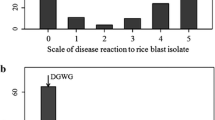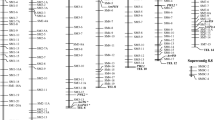Abstract
Rice blast, caused by the fungus Magnaporthe grisea, is a globally important disease of rice that causes annual yield losses. The segregation of genes controlling the virulence of M. grisea on rice was studied to establish the genetic basis of cultivar specificity in the interaction of rice and M. grisea. The segregation of avirulence and virulence was studied in 87 M. grisea F1 progeny isolates from a cross of two isolates, Guy11 and JS153, using resistance-gene-differential rice cultivars. The segregation ratio indicated that avirulence and virulence in the rice cultivars Aichi–asahi and K59, respectively, are controlled by single major genes. Genetic analyses of backcrosses and full-sib crosses in these populations were also performed. The χ2 test of goodness-of-fitness for a 1:1 ratio indicated that one dominant gene controls avirulence in Aichi-asahi and K59 in this population. Based on the resistance reactions of rice differential lines harboring known resistance genes to the parental isolates, two genetically independent avirulence genes, AVR–Pit and AVR–Pia, were identified. Genetic linkage analysis showed that the SSR marker m355–356 is closely linked to AVR–Pit, on the telomere of chromosome 1 at a distance of approximately 2.3 cM. The RAPD marker S487, which was converted to a sequence-characterized amplified region (SCAR) marker, was found to be closely linked to AVR–Pia, on the chromosome 7 telomere at a distance of 3.5 cM. These molecular markers will facilitate the positional cloning of the two AVR genes, and can be applied to molecular-marker-assisted studies of M. grisea populations.




Similar content being viewed by others
References
Berruyer R, Adreit H, Milazzo J, Gaillard S, Berger A, Dioh W, Lebrun MH, Tharreau D (2003) Identification and fine mapping of Pi33, the rice resistance gene corresponding to the Magnaporthe grisea avirulence gene ACE1. Theor Appl Genet 107:1139–1147
Bohnert HU, Fudal I, Dioh W, Tharreau D, Notteghem JL, Lebrun ML (2004) A putative polyketide synthase/peptide synthetase from Magnaporthe grisea signals pathogen attack to resistant rice. Plant Cell 16:2499–2513
Chen QH, Wang YC, Zheng XB (2004) Mating type distribution and fertility status of Magnaporthe grisea populations in main regions of China. Scientia Agricultura Sinica 37:840–845
Chen QH, Wang YC, Zheng XB (2006) Genetic diversity of Magnaporthe grisea in China as revealed by DNA fingerprint haplotypes and pathotypes. J Phytopathol 154(6):361–369
Cruz CMV, Bai JF, Ona I, Leung H, Nelson RJ, Mew TW, Leach JE (2000) Predicting durability of a disease resistance gene based on an assessment of the fitness loss and epidemiological consequences of avirulence gene mutation. Proc Natl Acad Sci USA 7:13500–13505
Dioh W, Tharreau D, Notteghem JL, Orbach M, Lebrun M (2000) Mapping of avirulence genes in the rice blast fungus, Magnaporthe grisea, with RFLP and RAPD markers. Mol PlantMicrobe Interact 13:217–227
Ellingboe AH, Wu BC, Robertson W (1990) Inheritance of avirulence/virulence in a cross of two isolates of Magnaporthe grisea pathogenic to rice. Phytopathology 80:108–111
Farman ML, Leong SA (1998) Chromosome walking to the AVR1–CO39 avirulence gene of Magnaporthe grisea: discrepancy between the physical and genetic maps. Genetics 150:1049–1058
Gottschling DE (1992) Telomere-proximal DNA in Saccharomyces cerevisae is refractory to methyltransferase activity in vivo. Proc Natl Acad Sci USA 89:4062–4065
Hayashi N, Li C, Li J, Iwano M, Naito H, Yoshino R, Kato H (1997) Distribution of fertile Magnaporthe grisea fungus pathogenic to rice in Yunnan Province, China. Ann Phytopathol Soc Jpn 63:316–323
Hayashi N, Ando I, Imbe T (1998) Identification of a new resistance gene to a Chinese blast fungus isolate in the Japanese rice cultivar Aichi–Asahi. Phytopathology 88:822–827
Joosten MHAJ, Cozijnsen AJ, De Wit (1994) Host resistance to a fungal tomato pathogen lost by a single base-pair change in an avirulence gene. Nature 367:284–386
Kamoun S, van West P, de Jong AJ, de Groot KE, Vleeshouwers VGAA, Govers F (1997) A gene encoding a protein elicitor of Phytophthora infestans is down-regulated during infection of potato. Mol Plant Microbe Interact 10:13–20
Kang S, Sweigard JA, Valent B (1995) The PWL host specificity gene family in the blast fungus Magnaporthe grisea. Mol Plant Microbe Interact 8:939–948
Kato H, Yamaguchi T (1982) The perfect state of Pyricularia oryzae Cav. from rice plants in culture. Ann Phytopathol Soc Jpn 48:607–612
Kaye C, Millazzo J, Rozenfeld S, Lebrun M, Tharreau D (2003) The development of simple sequence repeat markers for Magnaporthe grisea and their integration into an established genetic linkage map. Fungal Genet Biol 40(3):207–214
Kiyosawa S (1976) Pathogenic variations of Pyricularia oryzae and their use in genetic and breeding studies. SABRAO J 8:53–67
Kosambi DD (1944) The estimation of map distance from recombination value. Ann Eugen 12:172–175
Lander ES, Green P, Abrahamson J, Barlow A, Daly MJ, Lincoln SE, Newburg L (1987) MAPMAKER: an interactive computer package for constructing primary genetic maps of experimental and natural populations. Genomics 1:174–181
Leung H, Borromeo ES, Bernardo MA, Notteghem JL (1988) Genetic analysis of virulence in the rice blast fungus Magnaporthe grisea. Phytopathology 78:1227–1233
Louis EJ, Naumova ES, Lee A, Naumov G, Haber J (1994) The chromosome end in yeast: its mosaic nature and influence on recombinational dynamics. Genetics 136:789–802
Luo CX, Fujiata Y, Yasuda N, Hirayae K, Nakajima T, Hayashi N, Kusaba M, Yaegashi H (2004) Identification of Magnaporthe oryzae avirulence genes to three rice blast resistance genes. Plant Dis 88:265–270
Mandel MA, Crouch VW, Gunawardena UP, Harper TM, Orbach MJ (1997) Physical mapping of the Magnaporthe grisea AVR1–MARA locus reveals the virulent allele contains two deletions. Mol. Plant Microbe Interact 10:1102–1105
Michelmore RW, Paran I, Kesseli RV (1991) Identification of markers linked to disease-resistance genes by bulked segregation analysis: a rapid method to detect markers in specific genomic regions by using segregating population. Proc Natl Acad Sci USA 88:9828–9832
Notteghem JL, Silué D (1992) Distribution of the mating type alleles in Magnaporthe grisea populations pathogenic on rice. Phytopathology 82:421–424
Orbach MJ, Farrall L, Sweigard JA, Chumley FG, Valent B (2000) A telomeric avirulence gene determines efficacy for the rice blast resistance gene Pi-ta. Plant Cell 12:2019–2032
Ou SH (1985) Blast. In: Rice diseases, 2nd edn. Commonwealth Agricultural Bureaux, Wallingford, pp 109–201
Rohe M, Gierlich A, Hermann H, Hahn M, Schmidt B, Rosahl S, Knogge W (1995) The race-specific elicitor, NIP1, from the barely pathogen, Rhynchosporium secalis, determines avirulence on host plants of the Rrs1 resistance genotype. EMBO J 14:4168–4177
Sicard D, Legg E, Brown S, Babu NK, Ochoa O, Sudarshana P, Michelmore RW (2003) A genetic map of the lettuce downy mildew pathogen, Bremia lactucae, constructed from molecular markers and avirulence genes. Fungal Genet Biol 39:16–30
Silué D, Notteghem JL, Tharreau D (1992) Evidence of a gene-for-gene relationship in the Oryza sativa Magnaporthe grisea pathosystem. Phytopathology 82:577–580
Smith JR, Leong SA (1994) Mapping of a Magnaporthe grisea locus affecting rice (Oryza sativa) cultivar specificity. Theor Appl Genet 88:901–908
Sweigard JA, Valent B, Orbach MJ, Walter AM, Rafalski A, Chumley FG (1993) A genetic map of the rice blast fungus Magnaporthe grisea. In: O’Brien SJ (ed) Genetic maps. 6th ed. Cold Spring Harbor Laboratory, Cold Spring Harbor, pp 3.112–3.117
Sweigard JA, Carroll AM, Kang S, Farrall L, Chumley FG, Valent B (1995) Identification, cloning, and characterization of PWL2, a gene for host species specificity in the rice blast fungus. Plant Cell 7:1221–1233
Valent B, Chumley FG (1994) Avirulence gene and mechanisms of genetic instability in the rice blast fungus. In: Zeigler R, Leong SA, Teng PS (eds) Rice blast disease. CAB Int, Wallingford, pp 111–134
Van Kan JA, Van den Ackerveken GFJM, De Wit PJGM (1991) Cloning and characterization of cDNA of avirulence gene avr9 of the fungal pathogen Cladosporium fulvum, causal agent of tomato leaf mold. Mol Plant Microbe Interact 4:52–59
Wang YL, Kaye C, Bordat A, Henri AH, Milliazzo J, Zheng XB, Shen Y, Tharreau D (2005) Construction of genetic linkage map and location of avirulence genes from cross CH63 and TH16 of Magnaporthe grisea. Chin J Rice Sci 19:160–166
Yasuda N, Fujita Y, Noguchi M (2004) Identification of avirulence genes in the rice blast fungus corresponding to three resistance genes in Japanese differentials. J Gen Plant Pathol 70:202–206
Zhu H, Choi S, Johnston AK, Wing RA, Dean RA (1997) A large insert (130 kb) bacterial artificial chromosome library of the rice blast fungus: genome analysis, contig assembly, and gene cloning. Fungal Genet Biol 21:337–347
Acknowledgments
This work was supported by grants from State 863 High Technology R&D Project of China National Science and Technology Support Program and Natural Science Foundation of Jiangsu Province (No.BK2003416). The authors thank Yueqiu He (the Department of Plant Protection, Yunnan Agricultural University) for the supply of seed materials used in this study. We are grateful to Ying Shen (China National Rice Research Institute, Hangzhou, China) for kindly providing M. grisea isolate Guy11.
Author information
Authors and Affiliations
Corresponding author
Additional information
Communicated by J. Perrez-Martin.
Rights and permissions
About this article
Cite this article
Chen, Q.H., Wang, Y.C., Li, A.N. et al. Molecular mapping of two cultivar-specific avirulence genes in the rice blast fungus Magnaporthe grisea . Mol Genet Genomics 277, 139–148 (2007). https://doi.org/10.1007/s00438-006-0179-8
Received:
Accepted:
Published:
Issue Date:
DOI: https://doi.org/10.1007/s00438-006-0179-8




